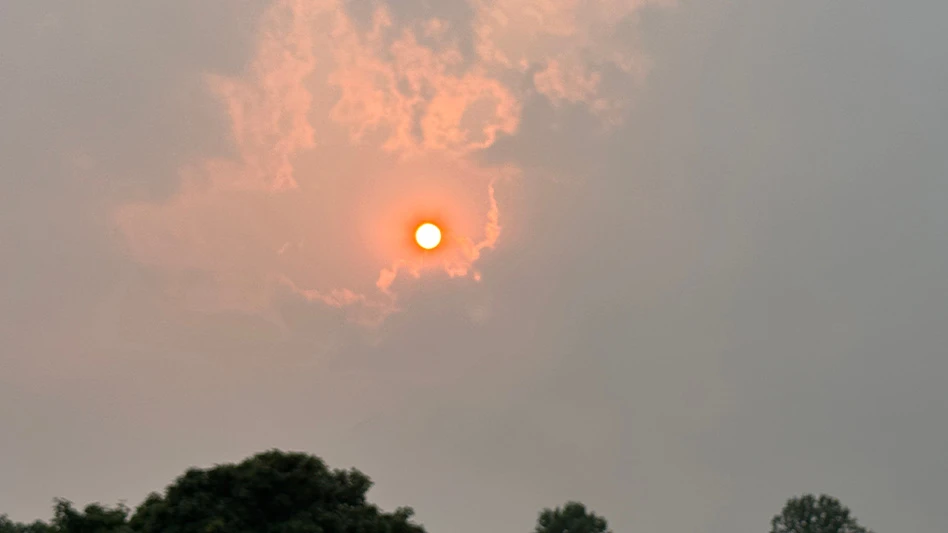
Courtesy of Caleb Fabry, Town & Country Pest Solutions
KINGSTON, N.Y. — As smoke and gray “Star Wars -like haze” continue to fill northern U.S. skies trickling down from wildfires burning in eastern Canada, pest management professionals are ensuring safety is a top priority.
More than 400 wildfires were actively burning as of June 11, according to Canadian Interagency Forest Fire Centre, noting the weather patterns were expected to persist for the next several days.
Paul Alley, president of Pestmaster Services in Hudson Valley, Kingston, N.Y., said he hasn’t seen a blue sky in several days.
“The sun was orange, almost like an opening scene from Star Wars where the two moons are coming together like an orange disc in the sky,” he said. “It looked like the rapture was coming.”
Alley told PCT his service technicians have been advised to wear masks while conducting outdoor services, and he’s noticed customers are taking precautions as well.

While his employees are taking safety measures to keep their health a main priority, it’s still “business as normal for technicians.”
“I was coming back into the office and I caught two of my office staff outside [looking up] in awe,” Alley said. “They saw me come around the corner and they tried to run back into the office because there was nobody listening for the phones for the 30 seconds that they were outside.”
Alley said he has not experienced any symptoms himself with his firefighter background, but his daughter is having some respiratory issues.
“They've canceled all outdoor activities for our schools and all field trips have been canceled,” he said. “It's the end of the year and the kids are getting upset.”
Caleb Fabry, president of Town & Country Pest Solutions, Rochester, N.Y., told PCT the skies have looked like what you would assume is from a war.
“We had a couple of customers reschedule because they didn't want to leave the house because of the hazardous air level the news was sharing,” he said. “We also had a couple of situations where technicians discussed issues with allergy-type symptoms with itching or breathing, but all in all, everyone continued on.”
From a pest perspective, Fabry said the company has seen a huge increase in the past three days of eight to 10 different swarm calls for honeybees.
“While researching this, I found that honeybees tend to get very stressed out by wildfire smoke so badly that it causes the main hive to split and go in search of new food and resources to live,” he said. “When we compare this smoke situation to other years, we are lucky to get eight honeybee swarm splits in an entire year.”
Ironically enough, Fabry said the company does full beehive extractions in homes and collect swarms to raise honeybees at their office location.

“We have several [swarms] right now, and they are producing so much honey,” he said. “I think it's kind of neat, especially from a marketing standpoint that we, as a pest control company, are not out killing the bees, but we are saving and raising the bees!”
Michel Maheu, general manager at Maheu&Maheu, Quebec City, said from his understanding the wildfire smoke passed over Quebec and has mostly impacted upstate New York, thus far dealing with minimal issues in his service area.
"[It is] hard to tell what impact it has on the business at this point," Maheu said. "My guess is that cold weather is slowing it down a bit. Air quality is bad in Montreal and the advice of public health is to remain indoors as much as possible."
Wildfire Smoke Safety Reminders.
The Center for Disease Control (CDC) and Prevention and the National Institute for Occupational Safety and Health (NIOSH) shared safety information for outdoor workers being exposed to wildfire smoke.
While the risk of experiencing symptoms and adverse health effects due to smoke exposure varies from person to person, adding respirators and masks may be one of the easiest controls to implement for limiting a worker’s exposure to the particulate matter in wildland smoke, and in some cases may be the only option to protect some workers, the organizations said
CDC and NIOSH also advised:
- If safety measures are not properly taken, symptoms can include eye irritation; sore throat; coughing; respiratory issues; asthma; chronic obstructive pulmonary disease (COPD) and more.
- Long work schedules and physical demands of the work performed may impact a worker’s exposures and health response to wildfire smoke.
Here are some ways outdoor workers, which can include pest control service technicians, can reduce smoke exposure and potential health risks, according to the CDC and NIOSH:
- Relocate or reschedule work tasks to smoke-free or less smoky areas;
- Reduce levels of physical activity when possible, especially strenuous and heavy work;
- Require and encourage workers to take frequent breaks in places that are free from smoke;
- Limit the worker’s smoke exposure by making accommodations for that worker to perform duties indoors or in a location that reduces exposure to smoke, if possible.
Latest from Pest Control Technology
- How to Identify Clover Mites
- Termite Threat Halted in Southern Florida
- PCT Media Group Adds Managing Editor Katie Hobbins
- Evens Clerjuste on Team Communication as Company Growth Point
- GPMA 2025 Announces Theme, Advancing Public Health Through Sustainable Pest Control
- BASF's Freder Medina Reviews Termite Control, Products in Latest Market Report
- What’s Up in Washington?
- PCT Awards Gift Cards to Cockroach, Ant Survey Participants





